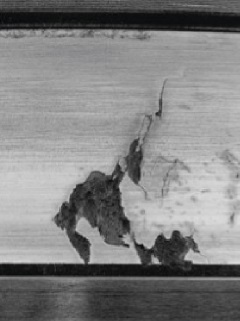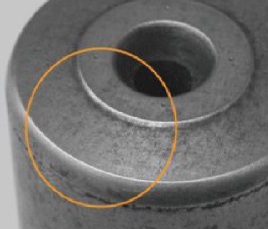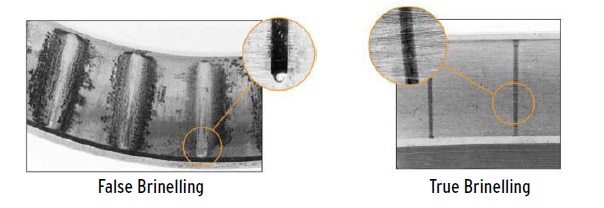Analyzing bearing damage
Josh Fernatt, Contributing Editor | TLT Commentary February 2013
Be prepared. You’ll need a combination of detective skills to find your answers.
KEY CONCEPTS
•
Recognizing and correcting common forms of bearing damage are invaluable skills for keeping machines up and running efficiently.
•
Four damage modes (mechanical, chemical, thermal and electrical) are responsible for the majority of bearing damages.
•
While recognizing a damaged bearing can be easy, determining the cause of the damage often is difficult.
WEBINARS: A NEW SERIES FROM TLT
This article is the second in a year-long series based on Webinars originally presented by STLE University. In some cases the Webinar presenter will author the article, and in others, like this one, the Webinar is adapted by a TLT writer.
STLE-member Dr. Paul Shiller is a research scientist with the University of Akron in Akron, Ohio, as well as an adjunct professor of chemistry at Kent State University in Kent, Ohio. He has a master’s degree in chemical engineering and a doctorate in physical chemistry. This article is based on a Webinar he conducted for STLE University in March 2011. You can reach Paul at
paul.shiller@uakron.edu.
STLE University has sponsored dozens of Webinars and podcasts on a wide range of technical topics. To see Paul Shiller’s Webinar in its entirety, review all STLE University offerings and view the lineup of future events, log on to
www.stle.org. Webinars are $39 to STLE members and $59 for non-members.
 Dr. Paul Shiller
Dr. Paul Shiller
THE CRITICAL ROLE BEARINGS PLAY in controlling and limiting the movement of machine elements makes rapid diagnosis and repair of damaged bearings essential.
Indeed, the ability to recognize and correct the most common forms of bearing damage is an invaluable skill for keeping machines up and running efficiently. Determining exactly which factors contribute to bearing wear or damage requires an understanding of the common causes of damage, which can include a combination of insufficient lubrication, improper maintenance practices or even faulty mounting. Taking steps to prevent these causes can save both time and money and ultimately extend bearing life.
Understanding bearing damage and the steps you can take to prevent it was the topic of an STLE University Webinar in March 2011 by Dr. Paul Shiller, an STLE member and research scientist in the University of Akron’s Civil Engineering Department in Akron, Ohio.
According to Shiller, four primary damage modes—mechanical, chemical, thermal and electrical—are responsible for the majority of bearing damages. The first damage mode, mechanical, is also the most frequent cause of bearing damage. Mechanical damage modes include particulate abrasions, spalling, impacts and brinelling.
Following is a condensation of Dr. Shiller’s Webinar. To hear the Webinar in its entirety, review the schedule of all STLE University Webinars and see a listing of upcoming Webinars and podcasts, log on to
www.stle.org.
MECHANICAL DAMAGE MODE
According to Shiller, abrasive damage occurs when foreign particulates enter a bearing and begin wearing away surface material. Though high-precision bearings can be knocked out of service at the first sign of minor wear, larger bearings, such as the rolling mill roll-neck bearings used in making steel, may continue to operate without issue if the damage is identified and addressed in time.
Fine abrasives such as sand, dirt and metal flakes can cause a substantial amount of damage to the bearing surface over time. When larger particles of dirt or metal are involved, more serious damage scenarios known as denting and bruising can occur. As the harder, larger materials pass through the bearing, they may leave deep pitting upon contact, whereas the softer, finer materials scour and wear the surface down. Determining exactly where the abrasive materials originate will likely require an inspection of the entire mechanical system surrounding the bearing.
Shiller says the second mechanical damage mode, spalling, is characterized by the removal of large amounts of material from the bearing surface following cyclic fatigue. Spalling is usually a secondary condition caused when cracks and fissures that occur from denting and bruising eventually join to form one large damage area. Fatigue spalling occurs when bearings are misaligned or experience heavy loading that overwhelms the lubricant film and causes metal-to-metal contact. Spalling can be identified by observing damage that appears in the shape of an arrowhead, with the initial damage point located at the tip of the arrowhead spreading back and out. Spalling can also originate from inclusions in the metal from the use of non-bearing rated steel.
The final group of mechanical damage modes includes impacts and true brinelling. In these cases, mishandling or exposing the bearing to a shock load will produce indentations of the rollers. True brinelling also can result from improper mounting, using the wrong tools when mounting the bearing or simply dropping it. True brinelling can contribute to spalls and dents, and will often be signaled by noisy machine operation.
PREVENTING MECHANICAL DAMAGE
Effectively preventing the mechanical damage modes requires routinely applying a few common sense measures.
A good first step is ensuring a clean, particle-free lubricant is used in the bearing. It is also important to maintain a clean work area and clean tools to decrease the chance that foreign particles find their way into bearings during scheduled services. Regular inspection of bearing seals serves this same purpose. It is also good practice to keep bearings protected in their original packaging until they are ready for installation.
“If you want to prevent particulate damage, you have to make sure that nothing gets in from the outside,” Shiller says. “Generally, the lubricants that come from the major suppliers are clean. Where the particulate materials come in is in the transfer of the lubricants from place to place.”
 The “arrow head” pattern of fatigue spalling.
The “arrow head” pattern of fatigue spalling.
 The large roller end of a tapered roller worn away by abrasive material in the lubricant. The roller was manufactured without a shoulder on that surface, and the depth of the shoulder shows the amount of wear that can occur.
CHEMICAL DAMAGE MODE
The large roller end of a tapered roller worn away by abrasive material in the lubricant. The roller was manufactured without a shoulder on that surface, and the depth of the shoulder shows the amount of wear that can occur.
CHEMICAL DAMAGE MODE
The most common forms of chemical damage to bearings are etching and corrosion, which occur when water, humidity or other potentially corrosive substances infiltrate the bearing surface. Because the bearing race and rolling elements have a high degree of polish or finish, they are highly susceptible to corrosion damage.
Moisture can enter a bearing in various ways, including through failing seals or condensation generated from temperature fluctuations. The operating environment also can play a major role in corrosion for machines that are located offshore or in acidic settings. Additionally, fretting corrosion, or false brinelling, is caused by tiny vibration of the rollers on the raceway. These constant small movements of the rollers push the lubricant away from the contact, causing adhesive wear. As the adhesive wear continues, debris is generated, causing abrasive wear. The debris then can become oxidized and prolong the fretting wear, especially in hot or wet environments. By comparison, false brinelling wears away the bearing surface, while in true brinelling the original surface texture remains.
 A comparison of false brinelling and true brinelling. False brinelling is an adhesive/abrasive wearing of the surface; no grind lines are seen on the surface. True brinelling is an indenting of the surface; grind lines are seen on the surface through the brinell.
PREVENTING CHEMICAL DAMAGE MODES
A comparison of false brinelling and true brinelling. False brinelling is an adhesive/abrasive wearing of the surface; no grind lines are seen on the surface. True brinelling is an indenting of the surface; grind lines are seen on the surface through the brinell.
PREVENTING CHEMICAL DAMAGE MODES
Actions to prevent corrosion and etching include inspecting and replacing worn seals, monitoring the moisture levels of lubricants and ensuring that bearings are stored in dry areas and with a coating of lubricant or rust preventative. Much like inhibiting particulates from entering bearings, storing bearings in their original packaging until use can also prevent corrosion from forming on the bearing surface.
“In preventing etching and corrosion, seals would be one place to look,” Shiller says. “You want to inspect and maintain your seals. You want to monitor moisture levels in the lubricant— this would be incoming lubricant in either the original fill of the bearing or relubrication of the bearings.”
Shiller adds that inspecting a bearing to be sure it is dry following cleaning or servicing is an effective means of preventing unwanted moisture in the bearing, but operators also should be aware that in automated cleaning processes, the water- and oil-based components must be compatible. In cases where cleaning chemistries are incompatible, a potentially harmful residue may be left on the bearing surface.
THERMAL DAMAGE MODES
The movement within a properly operating bearing is protected by the presence of a lubricant film, which allows the roller elements to glide along the race without resulting in damage. Problems arise when metal-to-metal contact occurs. Common causes that lead to thermal damage in bearings are lubricant starvation, using the wrong lubricant or a lubricant system inappropriate for the operating environment. When one or more of these characteristics is present, it is likely that the bearing will begin to generate damaging levels of heat.
“Inadequate lubrication and heat damage generally shows itself in one of two ways. There is usually a color difference on the surface that shows thermal damage. Another thermal situation could result in microspalling or peeling of the surface,” Shiller says. “It’s not uncommon to see staining of bearing surfaces. If it’s a stain on the surface, meaning that you can’t wipe it off, you can’t get a solvent and clean it off, that’s not a problem. That’s additives interacting with the surface and doing their job.”
As temperatures in the bearing climb, the viscosity of the lubrication decreases until eventually the lubricant film degrades and metal-to-metal damage such as surface peeling occurs. Smearing is another thermal damage mode that results from inadequate lubrication. Smearing is defined as a transfer of surface material from the roller to the raceway as the two inadequately lubricated surfaces slide against one another. For example, large loads on skidding rollers, where the lubricant film is not maintained, exhibit high frictional heating that can cause steel to flow from one surface to another, also known as microwelding.
PREVENTING THERMAL DAMAGE MODES
Preventing thermal damage begins with ensuring that the proper amount and grade of lubrication reaches the bearing during operation. It is also important to confirm that the lubrication system is operational and flowing before the bearings are set in motion. Monitoring the temperature of the oil sump or inlet is also wise. “Proper flow rates and settings are also preventive measures for inadequate lubrication, and you need to maintain these systems,” says Shiller.
ELECTRICAL DAMAGE MODES
Electrical damage modes are less common but can result in significant damage to bearing systems. Electrical damage occurs when current is passed through the bearing. This may result from any action that passes current through the bearing material. Two examples, says Shiller, are a case where the machine was improperly grounded or where welding was performed on the machine while the bearings were rotating.
Electrical damage typically produces pitting and small burns on the bearing surface. When examined under magnification, the metal might appear to be melted to a certain extent. “Primarily what happens in electrical damage modes is machine noise and vibrations go very high, and it becomes unusable from that aspect,” says Shiller.
When a bearing fails, the response and repair will depend on the technician’s ability to uncover the root cause of the damage.
“Most companies in business today have some form of quality system in place that should set the procedures to make sure the damage does not occur in the future. The quality system will have some kind of maintenance section and possibly a lubrication maintenance and testing plan,” Shiller says.
“All of these should address how to fix the system when things go wrong,” he adds. “First the root cause needs to be corrected, followed by a temporary increase in the frequency of inspection or testing. Second is the need to educate the employees as to what happened, how to identify the problems and why it is important to keep the bearings in service.”
RECOGNIZING THE SIGNS
Signs to be aware of when faced with possible bearing damage are irregular noise and vibration. Additionally, if bearings are lubricated from a central sump, the oil should be tested on a regular basis. If debris is visible in the oil, it may be a clue that the bearings are experiencing wear.
“Other factors like an increased operating temperature, visible leaking of the bearing seals or an increase in the torque required to turn the bearing do not necessarily indicate bearing damage but do indicate something has changed. If these are different enough, then it might warrant a bearing inspection,” advises Shiller.
It is important to note that no single method covers all bearing operations. Maintenance is highly dependent on the environment of the bearing; whether bearings are operated continuously or intermittently, the bearing load and other factors can differ from application to application.
CONCLUSION
Whether found in precision dental instruments or the main shaft of a wind turbine, maintaining the flawless condition of bearings is an essential part of a successful machine operation. While the damage may be easily visible in the bearing itself, determining the cause may prove more difficult.
As ultra large bearings such as those found in wind turbines become more common, it is important to continue to study damage modes to analyze their contribution to wear and bearing longevity in new settings. Reviewing the complete installation, mounting and related parts of a bearing are key steps in determining what lies behind bearing damage and wear.
 Josh Fernatt is a free-lance writer who can be reached at josh.fernatt@gmail.com
Josh Fernatt is a free-lance writer who can be reached at josh.fernatt@gmail.com.